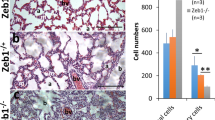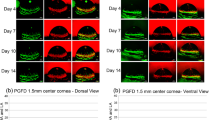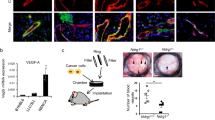Abstract
Corneal avascularity—the absence of blood vessels in the cornea—is required for optical clarity and optimal vision, and has led to the cornea being widely used for validating pro- and anti-angiogenic therapeutic strategies for many disorders1,2,3,4. But the molecular underpinnings of the avascular phenotype have until now remained obscure5,6,7,8,9,10 and are all the more remarkable given the presence in the cornea of vascular endothelial growth factor (VEGF)-A, a potent stimulator of angiogenesis, and the proximity of the cornea to vascularized tissues. Here we show that the cornea expresses soluble VEGF receptor-1 (sVEGFR-1; also known as sflt-1) and that suppression of this endogenous VEGF-A trap11 by neutralizing antibodies, RNA interference or Cre-lox-mediated gene disruption abolishes corneal avascularity in mice. The spontaneously vascularized corneas of corn1 and Pax6+/- mice12,13 and Pax6+/- patients with aniridia14 are deficient in sflt-1, and recombinant sflt-1 administration restores corneal avascularity in corn1 and Pax6+/- mice. Manatees, the only known creatures uniformly to have vascularized corneas15, do not express sflt-1, whereas the avascular corneas of dugongs, also members of the order Sirenia, elephants, the closest extant terrestrial phylogenetic relatives of manatees, and other marine mammals (dolphins and whales) contain sflt-1, indicating that it has a crucial, evolutionarily conserved role. The recognition that sflt-1 is essential for preserving the avascular ambit of the cornea can rationally guide its use as a platform for angiogenic modulators, supports its use in treating neovascular diseases, and might provide insight into the immunological privilege of the cornea.
This is a preview of subscription content, access via your institution
Access options
Subscribe to this journal
Receive 51 print issues and online access
$199.00 per year
only $3.90 per issue
Buy this article
- Purchase on Springer Link
- Instant access to full article PDF
Prices may be subject to local taxes which are calculated during checkout




Similar content being viewed by others
References
Sharma, P. V. Susruta-Samhita (Chaukhambha Visvabharati, Varanasi, India, 2001)
Magnus, H. Ophthalmology of the Ancients (J. P. Wayenborgh, Oostende, Belgium, 1999)
Meyer, K. & Chaffee, E. The mucopolysaccharide acid of the cornea and its enzymatic hydrolysis. Am. J. Ophthalmol. 23, 1320–1325 (1940)
Gimbrone, M. A., Cotran, R. S., Leapman, S. B. & Folkman, J. Tumor growth and neovascularization: an experimental model using the rabbit cornea. J. Natl Cancer Inst. 52, 413–427 (1974)
Chang, J. H., Gabison, E. E., Kato, T. & Azar, D. T. Corneal neovascularization. Curr. Opin. Ophthalmol. 12, 242–249 (2001)
Wiegand, S. J. et al. Genetic modulation of pigment epithelium-derived factor (PEDF) expression does not alter normal or pathological angiogenesis in the eye, or tumor growth. Invest. Ophthalmol. Vis. Sci. 45, abstr. 1884. (2004)
Cursiefen, C. et al. Roles of thrombospondin-1 and -2 in regulating corneal and iris angiogenesis. Invest. Ophthalmol. Vis. Sci. 45, 1117–1124 (2004)
Bugge, T., Flick, M., Daugherty, C. & Degen, J. Plasminogen deficiency causes severe thrombosis but is compatible with development and reproduction. Genes Dev. 9, 794–807 (1995)
Fukai, N. et al. Lack of collagen XVIII/endostatin results in eye abnormalities. EMBO J. 21, 1535–1544 (2002)
Hirsch, E., Irikura, V. M., Paul, S. M. & Hirsh, D. Functions of interleukin 1 receptor antagonist in gene knockout and overproducing mice. Proc. Natl Acad. Sci. USA 93, 11008–11013 (1996)
Kendall, R. L. & Thomas, K. A. Inhibition of vascular endothelial cell growth factor activity by an endogenously encoded soluble receptor. Proc. Natl Acad. Sci. USA 90, 10705–10709 (1993)
Smith, R. et al. Corn1: a mouse model for corneal surface disease and neovascularization. Invest. Ophthalmol. Vis. Sci. 37, 397–404 (1996)
Ramaesh, T. et al. Corneal abnormalities in Pax6+/- small eye mice mimic human aniridia-related keratopathy. Invest. Ophthalmol. Vis. Sci. 44, 1871–1878 (2003)
Jordan, T. et al. The human PAX6 gene is mutated in two patients with aniridia. Nature Genet. 1, 328–332 (1992)
Harper, J. Y., Samuelson, D. A. & Reep, R. L. Corneal vascularization in the Florida manatee (Trichechus manatus latirostris) and three-dimensional reconstruction of vessels. Vet. Ophthalmol. 8, 89–99 (2005)
Hiratsuka, S., Minowa, O., Kuno, J., Noda, T. & Shibuya, M. Flt-1 lacking the tyrosine kinase domain is sufficient for normal development and angiogenesis in mice. Proc. Natl Acad. Sci. USA 95, 9349–9354 (1998)
Fong, G. H., Rossant, J., Gertsenstein, M. & Breitman, M. L. Role of the Flt-1 receptor tyrosine kinase in regulating the assembly of vascular endothelium. Nature 376, 66–70 (1995)
Stechschulte, S. U. et al. Rapid ocular angiogenic control via naked DNA delivery to cornea. Invest. Ophthalmol. Vis. Sci. 42, 1975–1979 (2001)
Lin, Q., Jo, D., Gebre-Amlak, K. D. & Ruley, H. E. Enhanced cell-permeant Cre protein for site-specific recombination in cultured cells. BMC Biotechnol. 4, 25 (2004)
Jo, D. et al. Epigenetic regulation of gene structure and function with a cell-permeable Cre recombinase. Nature Biotechnol. 19, 929–933 (2001)
Hiratsuka, S. et al. Membrane fixation of vascular endothelial growth factor receptor 1 ligand-binding domain is important for vasculogenesis and angiogenesis in mice. Mol. Cell. Biol. 25, 346–354 (2005)
Gerber, H. P., Condorelli, F., Park, J. & Ferrara, N. Differential transcriptional regulation of the two vascular endothelial growth factor receptor genes. Flt-1, but not Flk-1/KDR, is up-regulated by hypoxia. J. Biol. Chem. 272, 23659–23667 (1997)
Ikeda, S. et al. Aberrant actin cytoskeleton leads to accelerated proliferation of corneal epithelial cells in mice deficient for destrin (actin depolymerizing factor). Hum. Mol. Genet. 12, 1029–1036 (2003)
Ambati, B. K. et al. Sustained inhibition of corneal neovascularization by genetic ablation of CCR5. Invest. Ophthalmol. Vis. Sci. 44, 590–593 (2003)
Ambati, B. K., Joussen, A. M., Kuziel, W. A., Adamis, A. P. & Ambati, J. Inhibition of corneal neovascularization by genetic ablation of CCR2. Cornea 22, 465–467 (2003)
Graubert, M. D., Ortega, M. A., Kessel, B., Mortola, J. F. & Iruela-Arispe, M. L. Vascular repair after menstruation involves regulation of vascular endothelial growth factor-receptor phosphorylation by sFLT-1. Am. J. Pathol. 158, 1399–1410 (2001)
Kearney, J. B., Kappas, N. C., Ellerstrom, C., DiPaola, F. W. & Bautch, V. L. The VEGF receptor flt-1 (VEGFR-1) is a positive modulator of vascular sprout formation and branching morphogenesis. Blood 103, 4527–4535 (2004)
Levine, R. J. et al. Circulating angiogenic factors and the risk of preeclampsia. N. Engl. J. Med. 350, 672–683 (2004)
Bergers, G. et al. Matrix metalloproteinase-9 triggers the angiogenic switch during carcinogenesis. Nature Cell Biol. 2, 737–744 (2000)
Dana, M. R. & Streilein, J. W. Loss and restoration of immune privilege in eyes with corneal neovascularization. Invest. Ophthalmol. Vis. Sci. 37, 2485–2494 (1996)
Acknowledgements
We thank the various aquaria, zoos and wildlife rehabilitation centres that donated tissues for comparative studies; R. Groom, S. Joshi, M. Kellogg, R. King, C. K. Lau, P. Lewis, N. Mezei, K.K. Smith and L. Xu for technical assistance; R. J. Kryscio for statistical guidance; and R. Mohan, S. Bondada, M. W. Fannon, L. Mazzaro, Y. Nozaki, P. A. Pearson, L. Peichl, A. M. Rao, G. S. Rao and K. Ambati for discussions. J.A. was supported by the NEI/NIH, the Lew R. Wasserman Merit Award (Research to Prevent Blindness), the Dennis W. Jahnigen Career Development Award (American Geriatrics Society, John A. Hartford Foundation, Atlantic Philanthropies), the Macula Vision Research Foundation, the International Retinal Research Foundation, the E. Matilda Ziegler Foundation for the Blind, the Dr E. Vernon Smith and Eloise C. Smith Macular Degeneration Endowed Chair, a physician–scientist award from University of Kentucky, and a departmental challenge grant from Research to Prevent Blindness; M.N. by ARVO/Japan National Society for the Prevention of Blindness; E.S. by Fight For Sight; R.J.C.A by Research to Prevent Blindness; J.Z.B. and B.R. by the NIDCD/NIH; A.T. by a Japan Young Scientist Award; B.K.A. by a VA Career Development Award, the Knights-Templar Eye Foundation and Fight for Sight; N.S by ARVO/Alcon; S.I. by the NEI/NIH; J.M.C. by the Wellcome Trust and the Birth Defects Foundation; T.S.K by the NEI/NIH and the NIAMS/NIH; S.B. by the Muscular Dystrophy Association; and S.D.F. by the AIRC (Italian Association for Cancer Research). Author Contributions B.K.A. and J.A. conceived and designed the experiments, wrote the manuscript, and are joint senior authors. M.N., N.S., A.T., P.D.J., J.Z.B. and B.J.R. contributed equally.
Author information
Authors and Affiliations
Corresponding author
Ethics declarations
Competing interests
B.K.A, J.A. and N.S. are listed as inventors on a patent application describing these findings.
Supplementary information
Supplementary Notes
This file contains Supplementary Figures and Legends 1–11, Supplementary Methods and Supplementary Notes. (PDF 1428 kb)
Rights and permissions
About this article
Cite this article
Ambati, B., Nozaki, M., Singh, N. et al. Corneal avascularity is due to soluble VEGF receptor-1. Nature 443, 993–997 (2006). https://doi.org/10.1038/nature05249
Received:
Accepted:
Published:
Issue Date:
DOI: https://doi.org/10.1038/nature05249
This article is cited by
-
Effect of a protein kinase B (Akt) inhibitor on the angiogenesis of HUVECs and corneal neovascularization
Wiener klinische Wochenschrift (2024)
-
Netrin-4: Focus on Its Role in Axon Guidance, Tissue Stability, Angiogenesis and Tumors
Cellular and Molecular Neurobiology (2023)
-
The lymphatic vascular system: much more than just a sewer
Cell & Bioscience (2022)
-
Adipose-derived stromal/stem cells are verified to be potential seed candidates for bio-root regeneration in three-dimensional culture
Stem Cell Research & Therapy (2022)
Comments
By submitting a comment you agree to abide by our Terms and Community Guidelines. If you find something abusive or that does not comply with our terms or guidelines please flag it as inappropriate.



